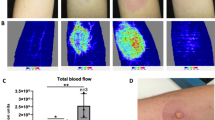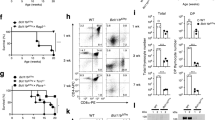Abstract
Mice primed with 4-hydroxy-3-nitrophenylacetyl-O-succini-mide (NP-O-Su) generate hapten-specific T cell-mediated contact or cutaneous hypersensitivity (CS) responses1. Analysis of the effector T cells mediating these in vivo responses suggested that multiple T-cell subpopulations were involved2. It has not been possible previously to separate these cell populations physically by conventional means. Therefore, to separate these cells and to provide a uniform source of CS effector cells for future analyses, we hybridized the CS effector cell population with AKR-derived BW5147 thymoma cells. We now describe five H–2-restricted hybridoma T-cell clones isolated from this fusion. Each hybridoma possesses haptenspecific CS activity and four also crossreact with 4-hydroxy-3-nitrophenylacetyl (NP) derivatives. Two of the hybridoma clones are specific for NP associated with H–2I gene products; two others for NP associated with H–2D products; and one for NP associated with H–2K gene products.
This is a preview of subscription content, access via your institution
Access options
Subscribe to this journal
Receive 51 print issues and online access
$199.00 per year
only $3.90 per issue
Buy this article
- Purchase on Springer Link
- Instant access to full article PDF
Prices may be subject to local taxes which are calculated during checkout
Similar content being viewed by others
References
Sunday, M. E., Weinberger, J. Z., Benacerraf, B. & Dorf, M. E. J. Immun. 125, 1601–1605 (1980).
Sunday, M. E. & Dorf, M. E. J. Immun. 127, 766–768 (1981).
Okuda, K., Minami, M., Furusawa, S. & Dorf, M. E. J. exp. Med. 154, 1838–1851 (1981).
Dennert, G., Weiss, S. & Warner, J. F. Proc. natn. Acad. Sci. U.S.A. 78, 4540–4543 (1981).
Lin, Y.-L. & Askonas, B. A. J. exp. Med. 154, 225–234 (1981).
Okuda, K., Minami, M., Ju, S.-T. & Dorf, M. E. Proc. natn. Acad. Sci. U.S.A. 78, 4557–4561 (1981).
Marcucci, F., Waller, M., Kirchner, H. & Krammer, P. Nature 291, 79–81 (1981).
Minami, M., Okuda, K., Furusawa, S., Benacerraf, B. & Dorf, M. E. J. exp. Med. 154, 1390–1402 (1981).
Bhattacharya, A., Dorf, M. E. & Springer, T. A. J. Immun. 127, 2488–2495 (1981).
Ju, S.-T., Benacerraf, B. & Dorf, M. E. Proc. natn. Acad. Sci. U.S.A. 75, 6192–6196 (1978).
Kanno, M., Takei, I., Suzuki, N., Tomioka, H. & Taniguchi, M. Proc. jap. Soc. Immun. 10, 41–42 (1980).
Leung, K. N. & Ada, G. L. Scand. J. Immun. 12, 481–487 (1980).
Ertl, H. C. J. Cell. Immun. 62, 38–49 (1981).
Gillis, S. & Smith, K. A. Nature 268, 154–156 (1977).
Reiss, C. S. et al. Proc. natn. Acad. Sci. U.S.A. 77, 5432–5436 (1980).
Kaufmann, Y., Berke, G. & Eshhar, Z. Proc. natn. Acad. Sci. U.S.A. 78, 2502–2506 (1981).
Author information
Authors and Affiliations
Rights and permissions
About this article
Cite this article
Minami, M., Okuda, K., Sunday, M. et al. H–2K-, H–2I- and H–2D- restricted hybridoma contact sensitivity effector cells. Nature 297, 231–233 (1982). https://doi.org/10.1038/297231a0
Received:
Accepted:
Issue Date:
DOI: https://doi.org/10.1038/297231a0
Comments
By submitting a comment you agree to abide by our Terms and Community Guidelines. If you find something abusive or that does not comply with our terms or guidelines please flag it as inappropriate.



